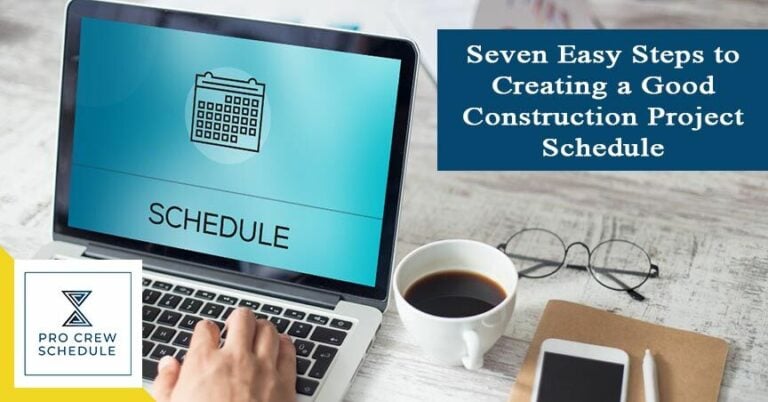Whether you are new or a seasoned project manager, it can still be intimidating and hard to figure out how to plan a good construction schedule for your specific project. Since no two projects are the same, there are many factors that you should consider, like the client’s priorities, the budget, and following the law.
You may have heard this a million times, but the construction industry comprises a thousand moving parts. As a project manager, your critical responsibility is to monitor and manage everything. To keep your crew members on track, know who is doing what and when, and see how everything fits together, you need to have a good project schedule with clear plans, steps, and responsibilities. A good project schedule may take some time upfront, but it will improve efficiency, accountability, and clarity.
In this article, let us discuss the importance of a project schedule. We will also share a quick and easy guide you can use when making your schedule.
What is a Construction Project Schedule?
In a nutshell, a construction project schedule is a detailed plan – it lists the tasks, deadlines, and resources needed to complete the project. It gives you an overall look at how your project is doing and how it is progressing. Luckily, there are a lot of ways that you can use to create your schedule, like traditional ways of pen-and-paper to spreadsheets and construction scheduling software. With a glance, you and your crew members can easily see your timelines, project tasks, tasks that depend on other tasks, and the team members responsible for those tasks. As a result, you can track its progress in real-time and ensure you’re on the right track to success.
A well-thought-out schedule for your construction project is a plan to ensure its success. It ensures that the available resources are used well and that projects are finished on time and within budget. This section lists some of the benefits of having a good schedule.
Optimal Inventory and Resource Usage
A good schedule makes managing people, materials, and equipment more accessible. Utilizing construction management software extensions that offer resource management can help you keep track of your inventory levels. This way, your resources are always available whenever you need them, and there is less chance of downtime because of shortages.
Minimal Downtime
It can be expensive to wait because of downtime. Whether a delay in materials delivery or an equipment failure, these minor setbacks can turn into big problems if not solved immediately. The worst case is that these delays will have a high cost and time impact on the project. Your schedule allows you to spot these problems before they become worse.
Keep Within Budget
Costs tend to go up more than planned when project estimates are wrong. A well-planned schedule can show where initial estimates were wrong. It can also help with financial decisions by accurately predicting when a project will be finished.
Adds Stability to Projects
If a project is well-planned, there will likely be no surprises. There is more say over how the project will turn out. As a result, you can focus more on the more essential parts of managing a project, such as crew schedule or inventory management. Plus, all the small details make it hard to make changes at the last minute.
Better Quality Assurance and Control
When a project is well-planned, the quality and the client’s happiness go up. It makes sure that suitable building materials are available in the right amounts everywhere, reducing the risks of affecting the way your project is built. You can deliver high-quality projects on schedule and budget while ensuring the best value for your client’s investment.
Hit Your Milestones and Deadlines
Scheduling helps you keep track of all your activities, whether it is finished on time or not. You will know which are progressing quickly and who may need assistance to complete the task. They also know when to get help from subcontractors. So, finish the project by the due date. Using crew scheduling software can make the schedule more accessible because everyone can choose which tasks they need to do. This includes general contractors, architects, subcontractors, workers, and suppliers.
Ensure a Safe Working Environment
Safety is an essential part of any building project. Using a schedule, you can figure out when to wear safety gear like earplugs, goggles, and hard hats.
So, why is it Critical to Have a Good Construction Project Schedule?
The success of your project depends on how well it is planned. Proper scheduling ensures the construction project is done on time and within budget by showing how the tasks are done, how fast or slow they are done, and how and in what order the materials are delivered. With a construction schedule, a company can figure out if the client’s deadlines are realistic.
A detailed construction schedule lets you track how things are going and compare the actual work to the schedule to see if things are going well. It can also be utilized to compare the actual performance and results to determine who is responsible for project delays caused by work strikes, requests for changes from the owner, and other unplanned events.
Seven Steps to Make a Good Schedule
Before starting your project, you must prepare your three baselines: scope, budget, and schedule. Putting together a building schedule for your next project may seem like a lot of work; however, we have listed here seven steps you can follow to make the process more smooth and seamless.
Have a Meeting with Your Stakeholders
The first step is to meet with all the important people involved – from the client and top-level management to the design team, the project management team, and your supervisors. The goal of this initial meeting is to find out the client’s needs, priorities, and goals and write them down. Do they have a tight budget? Or do they have a strict deadline?
List the Project’s Limits and Risks
Because of different limitations, not all requirements can be met. As stated earlier, there might be budget constraints, limited space, inclement weather, defective material, lack of workers, or stringent local building codes that you need to take note of. These risks may hurt a project’s goals, timeline, and budget. Your project can go off track because of limitations and risks – finding them early lets you plan your day around them.
Define Your Project’s Scope
The scope of a project says what it includes and what it does not include. It also makes it easier to control scope creep. For example, are you building a two-story home or a condominium? Contractors and customers must agree on the scope and lock it down. Knowing your project’s scope gives you a clear idea of the tasks you need to do and what its outcome should be.
Create A Roadmap
Next, you will have to estimate when the project will start and end—estimating when it will be done means breaking it into general tasks or activities. At the end of each phase, a milestone is reached, and milestones are the project’s checkpoints.
Submit Your Proposals and Estimates
Now that you have gathered all the project information and made a high-level plan, the next step is to create a project proposal. The project’s goals, scope, time frame, and budget are listed in a proposal. You should be able to defend why your costs or your schedules look like this and get your client’s insights.
Breakdown Your Activities into Smaller, Workable Tasks.
Once the customer agrees, the next step is to make a detailed construction schedule. Break the project down into detailed tasks to make an accurate schedule. Estimate how hard the task will be based on what you have done before. Put these tasks in order of importance based on their dependencies and limitations. You will also need to know when you need your resources and when to procure them. Using inventory management software can help you do this more accessible.
Finalize Your Construction Schedule
Once you have written down and ranked all the tasks, you can make the building construction schedule. You can use the power of construction project management software add-ons to create your schedule and share it with your team.
What is Next After You Are Done Establishing Your Schedule?
A project timeline helps people get more work done in less time. A well-thought-out plan allows you to keep track of every tiny detail, and you will feel less stressed and get done. Keeping your project schedule and all project assets in one place will help everyone have a single source of truth and ensure everyone is using the most up-to-date project schedule.
Once you have finalized your schedule, start by sending everyone involved the project schedule and asking for specific feedback. Stay organized by giving everyone a central place to send their answers and a firm deadline to encourage team members to act quickly. Once you have all the feedback, you can adjust your schedules. Also, ensure that your project schedule is included in your brief and executive summary.
Once you have started the project, keep an eye on the schedule. Make a change management plan to change your schedule if something unexpected happens.







